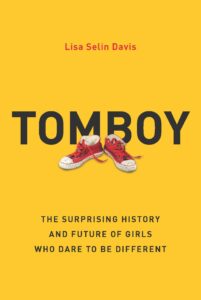Pocahontas, Buffy, and New Heroines by Lisa Selin Davis, book excerpt, TOMBOY: The Surprising History and Future of Girls Who Dare to Be Different
 Ode to Jo
Ode to Jo
Pocahontas, Buffy, and New Heroines
Around the time that Girl Power and Sporty Spice were drop- kicking the tomboy off the screen, a new publishing trend emerged: girl crisis literature, inspired in part by the American Association of University Women’s 1991 report Shortchanging Girls, Short- changing America.2 The report found that girls’ self-esteem plum- meted in adolescence and that boys were outperforming them all over the map, in school and at work. Mary Pipher’s 1994 book Reviving Ophelia: Saving the Selves of Adolescent Girls joined several similarly themed books that same year, and literature about the crisis of low self-esteem, declining academic performance, and eating disorders among America’s female adolescents itself became an industry. It promoted a problem that Girl Power—the sexy, commercialized version, not the Riot Grrrl version—seemed to solve in a way that the promotion of tomboyism in the 1970s hadn’t. Girl Power must have reached far more girls than tomboy- ism did.
The crisis, it turns out, was mostly found among middle-class white girls, something the media, so populated by middle-class white people, failed to note. If white girls were becoming meek in adolescence, African-American girls were being reprimanded for not being meek enough—a continuing problem. Today, African- American girls get suspended six times as often as white girls, not because they misbehave more, but because they get punished more for the same behaviors.3 When girls of color are aggressive, it’s often seen as unfeminine and uncool by people in power. When middle-class white girls are aggressive, it’s empowerment. For reference: John McEnroe’s on-court tantrums were criticized, but generally seen as benign, and parlayed into comedy and marketing opportunities. Serena Williams has been punished for hers. Often, the double-standards of race and gender rear their heads together. But Girl Power and girl crisis literature, however white, did change the media landscape. A new crop of shows with smart, complex female—and feminine—heroines made their debuts in the late nineties, from Nickelodeon’s Clarissa Explains It All to The Powerpuff Girls. A few more assertive, nonwhite (but still problematic) characters entered the mix, as well. Mulan and Pocahontas, while critiqued for their slanted portrayal of race and historical events, appeared among the cabal of waiting-to-be-rescued white Disney princesses who came before. Feminine action heroines popped up on the small screen, from Buffy the Vampire Slayer to Xena: Warrior Princess. Far tougher than Wonder Woman, whose breasts bounced impractically while chasing down bad guys in high-heeled boots, these new heroines’ outfits made sense from a physics standpoint.
But pink-powered action heroines were definitely highly feminine, and definitely not like the 1970s and ’80s tomboys who had filled our screens. Who needs a tomboy like Jo Polniaczek, fixing motorcycles and talking smack in a leather jacket with an unfemi- nine scowl on her (admittedly very pretty) face, when you’ve got Buffy, somehow defanging a vampire while appearing totally unthreatening? Many of these new female characters were strong but less masculine than traditional tomboys.
Who runs the world? Girls, Beyoncé told us in 2011, while riding a bucking steed in high-heeled boots, surrounded by a cast of scantily clad women.
Taming the Tomboy
When I asked a group of children’s media professionals for examples of post-1990s tomboys, they mentioned Rainbow Dash on My Little Pony, or The Powerpuff Girls—often cited as the first feminist show for kids. They listed Anna from Frozen, Nella the Princess Knight, Moana, Jessie from the Toy Story franchise, Edith from Despicable Me, Merida from Brave, Judy Hopps from Zootopia. (Post-1990s tomboys seem to be more common in animated, and not always human, form.) They mentioned the Disney show Liv and Maddie, in which Liv is the girliest girl on the planet and Maddie, her identical twin sister, is the tomboy because she’s competitive and likes sports. But both girls, played by Dove Cameron, are quite traditionally feminine-looking. They mentioned movies like Miss Congeniality, but I don’t see as much of our beloved Jo in them as I’d like.
Even when tomboyish characters appeared in films like Bend It Like Beckham or The Hunger Games, the post–Girl Power char- acters were much more feminine, and romance was still at the heart of their stories, with tomboy taming—transforming an
independent tomboy into somebody’s wife or girlfriend—in full effect. This happened in nineteenth-century tomboy novels, too. Much to Louisa May Alcott’s dismay, as mentioned earlier, she was forced by pressure from her publisher and her rabidly devoted readers—a Victorian-era version of Twitter—to marry Jo off.
This is not to say that there is anything wrong with being a feminine and/or heterosexual tomboy who marries, but rather that the rich variety of tomboy experiences, and their diverse gender expressions and sexualities, have not been well represented by the media, and even less so since the 1990s.
Or at least, that’s what it seemed like to me. But to Columbia University English and gender studies professor Jack Halberstam, there’s very little difference between any of these tomboys, Jo and Addie and Maddie and Watts. All of them were feminine tomboys who occupied “a pre-cisgender or pre-heterosexual stage, and that’s why it could be indulged,” he told me. “It was never considered to be a threat because it had already been given a space in the society, from Little Women on.” That is, these characters were allowed and encouraged and beloved because they seemed straight and cisgender. They weren’t crossing the line into lesbian and/or trans territory, into places once (and still, in many cases) considered deviant.
Today, in fact, there are more shows with gender nonconforming and trans characters, hugely important because representation matters. As communications professor George Gerbner wrote in 1976: “Representation in the fictional world signifies social existence; absence means symbolic annihilation.”4 The media shape our ideas of normalcy, and many gender-rebelling young characters on big and small screens are now presented as variations, not devia- tions, of gender: non-binary actor Ellie Desautels playing transgender student Michael Hallowell on NBC’s Rise; non-binary character Syd on the rebooted One Day at a Time; or Mark, the boy who wears girls’ clothes, on The Conners, along with characters on Modern Family, Glee, and Degrassi: Next Class. The organization GLAAD, which tracks depictions of LGBTQ+ people in the media, found that 6.4 percent of main characters on broadcast TV were LGBTQ+ in 2017–2018—the highest number ever,5 and higher than the per- centage of Americans who identify as LGBT, 4.5 percent per a 2017 Gallup poll (though that number seems far too small to me).
This is huge progress, especially when the few trans and even gay adult characters in the past were often portrayed as psychotic or homicidal, the villains in movies like Basic Instinct, Psycho, Silence of the Lambs, and Monster.
 Lisa Selin Davis is an essayist, novelist, and journalist who has written for major publications such as the New York Times, Wall Street Journal, Guardian, Time, Yahoo, and Salon, among many others. She lives with her family in New York. Davis continues to write for major publications such as the New York Times, Wall Street Journal, Women’s Day, Bustle, Salon, Yahoo, Time Out, and more, and her articles often open the door to both debate and celebration. Most recently, in December 2018, another article she wrote for the New York Times, “Like Tomboys and Hate Girlie Girls? That’s Sexist”, went viral and sparked almost 400 comments. In 2017, her Guardian article “For Years I Thought She Was Stealing My Identity Until I Found Her” sparked 551 comments and record-breaking shares for the paper. Visit http://www.lisaselindavis.com/.
Lisa Selin Davis is an essayist, novelist, and journalist who has written for major publications such as the New York Times, Wall Street Journal, Guardian, Time, Yahoo, and Salon, among many others. She lives with her family in New York. Davis continues to write for major publications such as the New York Times, Wall Street Journal, Women’s Day, Bustle, Salon, Yahoo, Time Out, and more, and her articles often open the door to both debate and celebration. Most recently, in December 2018, another article she wrote for the New York Times, “Like Tomboys and Hate Girlie Girls? That’s Sexist”, went viral and sparked almost 400 comments. In 2017, her Guardian article “For Years I Thought She Was Stealing My Identity Until I Found Her” sparked 551 comments and record-breaking shares for the paper. Visit http://www.lisaselindavis.com/.















